Cattleya
Cattleya (/ˈkætliə/)[2] is a genus of orchids from Costa Rica south to Argentina.[1] The genus is abbreviated C in trade journals.[3]
| Cattleya | |
|---|---|
 | |
| Cattleya labiata | |
| Scientific classification | |
| Kingdom: | Plantae |
| Clade: | Tracheophytes |
| Clade: | Angiosperms |
| Clade: | Monocots |
| Order: | Asparagales |
| Family: | Orchidaceae |
| Subfamily: | Epidendroideae |
| Subtribe: | Laeliinae |
| Genus: | Cattleya Lindl. |
| Type species | |
| Cattleya labiata | |
| Synonyms[1] | |
| |
Description
Epiphytic or terrestrial orchids with cylindrical rhizome from which the fleshy noodle-like roots grow. Pseudobulbs can be conical, spindle-shaped or cylindrical; with upright growth; one or two leaves growing from the top of them. The leaves can be oblong, lanceolate or elliptical, somewhat fleshy, with smooth margin. The inflorescence is a terminal raceme with few or several flowers. Flowers have sepals and petals free from each other; the lip or labellum (lowermost petal), usually has a different coloration and shape from the rest of the flower and covers in part the flower column forming a tube. There are four polliniums (bag-like organs that contain pollen). The fruit is a capsule with many small seeds.[4][5][6]
Taxonomy
The genus was named in 1824 by John Lindley after horticulturalist William Cattley. Cattley obtained a specimen of then unnamed Cattleya labiata from William Swainson who had discovered the new plant in Pernambuco, Brazil, in 1817. The plant successfully bloomed under the care of Cattley and it became the type specimen from which Lindley described C. labiata.[7]
Currently accepted species and subgeneric division within genus Cattleya are:[8][9][10][11][12][13]
Subgenus Cattleya
Section Cattleya
| Image | Name | Distribution | Elevation (m) |
|---|---|---|---|
_B.S.Williams_%26_T.Moore%2C_Orchid_Album_2_t._84_(1883)_(48470977042).jpg) | C. aurea | S. Panama to Colombia | 300 - 1000 meters |
.jpg) | C. dowiana | Costa Rica | 250 - 1200 meters |
 | C. gaskelliana | Colombia to Trinidad | 700 - 1000 meters |
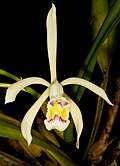 | C. iricolor | Ecuador to Peru | 400 - 1220 meters |
_(49221659452)_(cropped).jpg) | C. jenmanii | Venezuela to Guyana | 300 - 600 meters |
 | C. labiata | Brazil | 600 - 900 meters |
_(41995788111).jpg) | C. luteola | N. Brazil, Ecuador to Bolivia | 100 - 1200 meters |
 | C. mendelii | NE. Colombia | 1300 - 1800 meters |
.jpg) | C. mooreana | Peru | around 990 meters |
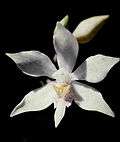 | C. mossiae | N. Venezuela | 900 - 1500 meters |
_O'Brien_Gard._Chron.%2C_n.s.%2C_20-_404_(1883)_(38372342694).jpg) | C. percivaliana | Colombia to W. Venezuela | 1300 - 2000 meters |
.jpg) | C. quadricolor | Colombia | 600 - 1500 meters |
| C. rex | Peru to N Bolivia | around 1350 meters | |
.jpg) | C. schroederae | NE. Colombia | . |
.jpg) | C. trianae | Colombia | around 1200 meters |
_(46699509212)_(cropped).jpg) | C. warneri | E. Brazil | 400 - 900 meters |
_2-_112_(1854)_(35156784005).jpg) | C. warscewiczii | Colombia | 500 - 1700 meters |
Series Cattleyodes
| Image | Name | Distribution | Elevation (m) |
|---|---|---|---|
 | C. crispa | SE. Brazil | 800 - 1500 meters |
| C. grandis | Brazil - SE. Bahia to N. Espírito Santo | . | |
 | C. lobata | SE. Brazil. | |
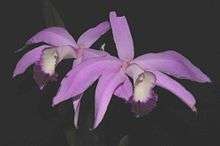 | C. perrinii | SE. Brazil | 700 - 900 meters |
_Rollisson_ex_Lindl.%2C_Gard._Chron._1855_319_(1855)_(42929804561).jpg) | C. purpurata | SE. & S. Brazil | |
 | C. tenebrosa | Brazil - SE. Bahia to Espírito Santo | . |
| C. virens | SE. Brazil | 1000 - 1500 meters | |
_(Lindl.)_Van_den_Berg%2C_Neodiversity_3-_12_(2008)_(35756189832).jpg) | C. xanthina | Brazil - Bahia to Espírito Santo | . |
Series Hadrolaelia
| Image | Name | Distribution | Elevation (m) |
|---|---|---|---|
_(Brieger_%26_Bicalho)_Van_den_Berg%2C_Neodiversity_3-_4_(2008)_(32091365561).jpg) | C. alaorii | Brazil - Bahia | 200 - 600 meters |
_(26737176929).jpg) | C. bicalhoi | Brazil - S. Minas Gerais to Rio de Janeiro | 500 - 2000 meters |
_Van_den_Berg%2C_Neodiversity_3_8_(2008)_(26476434407).jpg) | C. jongheana | Brazil - Minas Gerais | 1300 - 1600 meters |
_Van_den_Berg.jpg) | C. praestans | SE. Brazil | 300 - 500 meters |
| C. pumila | SE. & S. Brazil | 600 - 1300 meters | |
_Van_den_Berg%2C_Neodiversity_3-_11_(2008)_(34363216995).jpg) | C. sincorana | Brazil - Bahia | 1100 - 1500 meters |
Series Microlaelia
| Image | Name | Distribution | Elevation (m) |
|---|---|---|---|
 | C. lundii | Bolivia to Argentina | 740 - 1000 meters |
Series Parviflorae
| Image | Name | Distribution | Elevation (m) |
|---|---|---|---|
| C. alvarenguensis | Brazil - Minas Gerais | around 800 meters | |
.jpg) | C. alvaroana | Brazil - Rio de Janeiro | |
 | C. angereri | Brazil - Minas Gerais | 1000-1300 meters |
_Van_den_Berg%2C_Neodiversity_3-_4_(2008)._(39333106224).jpg) | C. blumenscheinii | Brazil - Minas Gerais | around 1200 meters |
| C. bradei | Brazil - Minas Gerais | 1100 - 1400 meters | |
| C. briegeri | Brazil - Minas Gerais | around 1370 meter | |
| C. campacii | Brazil | ||
 | C. caulescens | Brazil - Minas Gerais | 600 - 1200 meters |
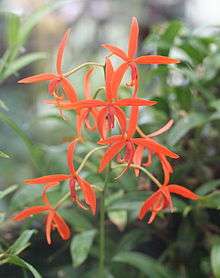 | C. cinnabarina | Brazil - S. Minas Gerais, Rio de Janeiro | 800 - 1500 meters |
.jpg) | C. colnagoi | Brazil - Minas Gerais | |
| C. conceicionensis | Brazil - Minas Gerais | 800 - 1200 meters | |
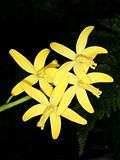 | C. crispata | Brazil - Minas Gerais | 400 - 1200 meters |
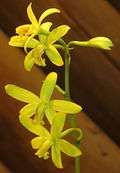 | C. endsfeldzii | Brazil - Minas Gerais | 900 meters |
 | C. esalqueana | Brazil - Minas Gerais | 1100 - 1300 meters |
| C. flavasulina | Brazil - Minas Gerais | 900 - 1440 meters | |
 | C. fournieri | Brazil - Minas Gerais | 1100 - 1800 meters |
_Van_den_Berg%2C_Neodiversity_3_7_(2008)_(40973783720).jpg) | C. ghillanyi | Brazil - Minas Gerais | |
| C. gloedeniana | Brazil - São Paulo | around 1600 meters | |
| C. gracilis | Brazil - Minas Gerais: Serra do Cipó | ||
| C. guanhanensis | Brazil - Minas Gerais | around 1100 meters | |
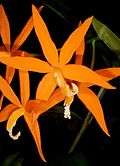 | C. harpophylla | Brazil - Minas Gerais to Espírito Santo | 500 - 900 meters |
| C. hatae | Brazil - Minas Gerais | 1000 - 1100 meters | |
| C. hegeriana | Brazil - Rio de Janeiro | 1000 - 1200 meters | |
| C. hispidula | Brazil - Minas Gerais | around 1200 meters | |
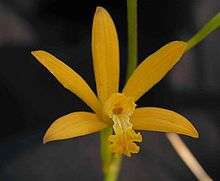 | C. hoehnei | Brazil - Espírito Santo | around 800 meters |
| C. itambana | Brazil - Minas Gerais | 1500 to 2200 meters | |
| C. kautskyana | Brazil - Espírito Santo | 600 - 1000 meters | |
| C. kettieana | Brazil - Minas Gerais | 1500 - 2000 meters | |
_Van_den_Berg%2C_Neodiversity_5_13_(2010)_(48000446356).jpg) | C. kleberi | Brazil - Minas Gerais | around 1100 meters |
| C. liliputana | Brazil - Minas Gerais: Serra do Ouro Branco | 1200 - 1400 meters | |
| C. locatellii | Brazil - Minas Gerais | ||
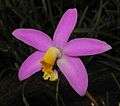 | C. longipes | SE. Brazil - Serra do Cipó | 1300 - 2000 meters |
 | C. luetzelburgii | Brazil - Bahia | 1100 - 1700 meters. |
| C. macrobulbosa | Brazil - Espírito Santo | around 1600 meters | |
 | C. marcaliana | Brazil - Bahia | 200 - 300 meters |
| C. milleri | Brazil - Minas Gerais | 800 - 1300 meters | |
 | C. mirandae | Brazil - Minas Gerais | around 1300 meters |
_Van_den_Berg%2C_Neodiversity_3_10_(2008)_(42346340371).jpg) | C. munchowiana | Brazil - Espírito Santo | 1100 - 1300 meters |
_(41114245832).jpg) | C. neokautskyi | SE. Brazil | 600 - 1000 meters. |
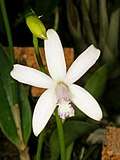 | C. pabstii | Brazil - Minas Gerais | 1200 meters |
| C. pendula | Brazil - Minas Gerais | ||
 | C. pfisteri | Brazil - Bahia | around 1300 meters |
| C. presidentensis | Brazil - Minas Gerais | 1000 - 1300 meters | |
.jpg) | C. reginae | Brazil - Minas Gerais | 1200 - 2000 meters |
_Van_den_Berg%2C_Neodiversity_3_11_(2008)_(26248496577).jpg) | C. rupestris | Brazil - Minas Gerais | |
| C. sanguiloba | Brazil – Bahia | ||
| C. tereticaulis | Brazil - Minas Gerais | ||
| C. vandenbergii | Brazil - Minas Gerais | ||
_Van_den_Berg%2C_Phytotaxa_186_84_(2014)_(30017905018).jpg) | C. vasconcelosiana | Brazil - Minas Gerais | around 1100 meters |
| C. verboonenii | Brazil - Rio de Janeiro | ||
| C. viridiflora | Brazil - Minas Gerais | ||
Series Sophronitis
| Image | Name | Distribution | Elevation (m) |
|---|---|---|---|
| C. acuensis | Brazil - Rio de Janeiro | 1800 - 2100 meters | |
| C. alagoensis | Brazil - Alagoas | 300 - 500 meters | |
_(Cogn.)_Van_den_Berg%2C_Neodiversity_3-_5_(2008)_(37604122515).jpg) | C. brevipedunculata | Brazil - Minas Gerais | 1220 - 2000 meters |
_Van_den_Berg%2C_Neodiversity_5_13_(2010)_(44597776830).jpg) | C. cernua | Brazil to NE. Argentina | 2 - 100 meters |
_(46224838001).jpg) | C. coccinea | Brazil to NE. Argentina | 650 - 1670 meters |
| C. dichroma | Brazil - Rio de Janeiro | 1200 - 1525 meters | |
 | C. mantiqueirae | SE. Brazil | 1200 - 1890 meters |
| C. pygmaea | Brazil - Espírito Santo | 915 - 1067 meters | |
_Van_den_Berg%2C_Neodiversity_3_12_(2008)_(40011443525).jpg) | C. wittigiana | Brazil - Espírito Santo | 700 - 2000 meters |
Section Lawrenceanae
| Image | Name | Distribution | Elevation (m) |
|---|---|---|---|
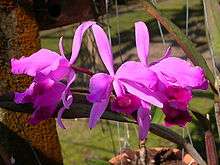 | C. lawrenceana | Venezuela, Guyana, N. Brazil | 250 - 2400 meters |
| C. lueddemanniana | N. Venezuela | 0 - 500 meters | |
 | C. wallisii | N. Brazil | |
Subgenus Cattleyella
| Image | Name | Distribution | Elevation (m) |
|---|---|---|---|
 | C. araguaiensis | Brazil | 395 - 610 meters |
Subgenus Intermediae
| Image | Name | Distribution | Elevation (m) |
|---|---|---|---|
| C. aclandiae | Brazil | 100 - 400 meters | |
 | C. amethystoglossa | Brazil | around 600 meters |
 | C. bicolor | SE. Brazil | |
_(Rchb.f.)_Rchb.f.%2C_Gard._Chron.%2C_n.s.%2C_17-_216_(1882)_(37827599194).jpg) | C. dormaniana | Brazil | 600 - 100 meters |
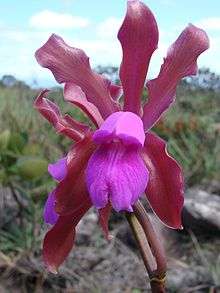 | C. elongata | Brazil | 900 - 1500 meters |
_(43353536482).jpg) | C. forbesii | Brazil | around 200 meters |
.jpg) | C. granulosa | Brazil | 600 - 900 meters |
_Lindl.%2C_Edwards's_Bot._Reg._17-_t._1406_(1831)_(24491178747).jpg) | C. guttata | Brazil | . |
 | C. harrisoniana | SE. Brazil | |
 | C. intermedia | SE. & S. Brazil, Paraguay, Uruguay | |
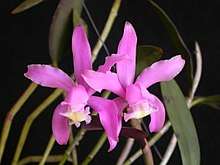 | C. kerrii | Brazil | |
 | C. loddigesii | SE. Brazil to NE. Argentina | . |
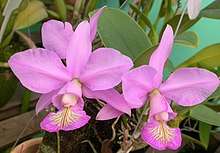 | C. nobilior | WC. Brazil to Bolivia | 170 - 700 meters |
| C. porphyroglossa | Brazil | . | |
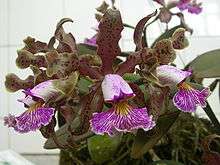 | C. schilleriana | Brazil | 0 - 800 meters. |
 | C. schofieldiana | Brazil | around 900 meters |
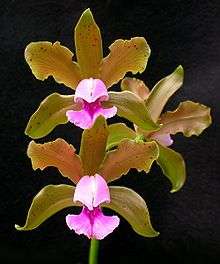 | C. tenuis | NE. Brazil | 1000 - 1200 meters. |
 | C. tigrina | SE. & S. Brazil | 0 - 100 meters. |
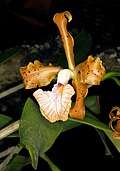 | C. velutina | Brazil | |
_Lindl.%2C_Gard._Chron._1842_472_(1842)_(29029280518).jpg) | C. violacea | lowland Amazon rainforest & Guyana | 200 - 700 meters |
.jpg) | C. walkeriana | WC. & SE. Brazil | 0 - 2000 meters. |
Subgenus Maximae
| Image | Name | Distribution | Elevation (m) |
|---|---|---|---|
_(43195894741).jpg) | C. maxima | Venezuela to Peru | 10 - 1500 meters |
Natural hybrids
Currently accepted natural hybrids are:[13]
- Cattleya × adrienne (= Cattleya pumila × Cattleya jongheana) (Brazil)
- Cattleya × albanensis
- Cattleya × amanda
- Cattleya × binotii (= ) (Brazil)
- Cattleya × brasiliensis (= C. bicolor × C. harrisoniana) (Brazil)
- Cattleya × braunae
- Cattleya × britoi (= C. crispata x C. mirandae) (Brazil - Minas Gerais)
- Cattleya × brymeriana (= C. violacea × C. wallisii) (N. Brazil).
- Cattleya × calimaniana (Brazil)
- Cattleya × calimaniorum (NE Brazil)
- Cattleya × carassana (Brazil)
- Cattleya × cattleyioides (Brazil)
- Cattleya × cipoensis (Brazil)
- Cattleya × colnagiana (Brazil).
- Cattleya × cristinae (Brazil).
- Cattleya × cypheri
- Cattleya × dasilvae
- Cattleya × dayana (= C. forbesii × C. guttata) (Brazil).
- Cattleya × deckeri
- Cattleya × delicata
- Cattleya × diamantinensis (= C. pfisteri × C. sincorana) (Brazil).
- Cattleya × dolosa (= C. loddigesii × C. walkeriana) (Brazil).
- Cattleya × dukeana (= C. bicolor × C. guttata) (SE. Brazil).
- Cattleya × duveenii (= C. guttata × C. harrisoniana) (SE. Brazil).
- Cattleya × elegans
- Cattleya × ericoi
- Cattleya × feldmanniana
- Cattleya × fidelensis (Brazil - Rio de Janeiro).
- Cattleya × frankeana
- Cattleya × gaezeriana
- Cattleya × gerhard-santosii
- Cattleya × gottoana
- Cattleya × gransabanensis (= C. jenmanii × C. lawrenceana) (Venezuela).
- Cattleya × gravesiana (= C. lueddemanniana × C. mossiae) (Venezuela).
- Cattleya × hardyana (= C. dowiana var.aurea × C. warscewiczii) (Colombia).
- Cattleya × heitoriana
- Cattleya × hummeliana
- Cattleya × hybrida (= C. guttata × C. loddigesii) (SE. Brazil).
- Cattleya × imperator (= C. granulata × C. labiata) (NE. Brazil).
- Cattleya × intricata (= C. intermedia × C. leopoldii) (S. Brazil).
- Cattleya × irrorata
- Cattleya × isaacii
- Cattleya × isabella (= C. forbesii × C. intermedia) (SE. Brazil).
- Cattleya × itabapoanaensis
- Cattleya × jetibaensis
- Cattleya × joaquiniana (= C. bicolor × C. walkeriana) (Brazil) .
- Cattleya × kautskyi (= C. harrisoniana × C. warneri) (SE. Brazil).
- Cattleya × kerchoveana
- Cattleya × labendziana
- Cattleya × lambari
- Cattleya × lilacina
- Cattleya × lucieniana (= C. forbesii × C. granulosa) (SE. Brazil).
- Cattleya × macguiganii
- Cattleya × measuresii (= C. aclandiae × C. walkeriana) (E. Brazil).
- Cattleya × mesquitae (= C. nobilior × C. walkeriana) (Brazil).
- Cattleya × mingaensis
- Cattleya × mixta (= C. guttata × C. schofieldiana) (Brazil).
- Cattleya × moduloi (C. schofieldiana × C. warneri) (Brazil).
- Cattleya × mucugensis
- Cattleya × neocalimaniana
- Cattleya × neocalimaniorum
- Cattleya × neoreginae
- Cattleya × nesyana
- Cattleya × occhioniana
- Cattleya × odiloniana
- Cattleya × patrocinii (= C. guttata × C. warneriana) (SE. Brazil).
- Cattleya × picturata (= C. guttata × C. intermedia) (SE. Brazil).
- Cattleya × pittiana
- Cattleya × porphyritis
- Cattleya × porphyrophlebia
- Cattleya × raganii
- Cattleya × resplendens (= C. granulosa × C. schilleriana) (NE. Brazil)
- Cattleya × rigbyana
- Cattleya × ruschii
- Cattleya × sancheziana
- Cattleya × schroederiana
- Cattleya × schunkiana
- Cattleya × schunkii
- Cattleya × scita (= C. intermedia × C. tigrina) (S. Brazil).
- Cattleya × sgarbii
- Cattleya × sororia
- Cattleya × tenuata (= C. elongata × C. tenuis) (Brazil) .
- Cattleya × varelae
- Cattleya × venosa (= C. forbesii × C. harrisoniana) (Brazil).
- Cattleya × verelii
- Cattleya × victoria-regina ( C. guttata × C. labiata) (NE. Brazil).
- Cattleya × victoriacarolinae
- Cattleya × wetmorei
- Cattleya × whitei
- Cattleya × wilsoniana (= C. bicolor × C. intermedia). (Brazil).
- Cattleya × wyattiana (= C. crispa × C. lobata). (Brazil).
- Cattleya × zaslawskii (= C. harpophylla × C. praestans). (Brazil).
- Cattleya × zayrae (= C. amethystoglossa × C. elongata). (Bahia, Brazil)
Nothogenera
- This section is incomplete.
Hybrids of Cattleya and other genera are placed in the following nothogenera:
- Brassocattleya = Brassavola × Cattleya
- Brassolaeliocattleya = Brassavola × Cattleya × Laelia
- Cattleytonia = Cattleya × Broughtonia
- Rhyncholaeliocattleya = Rhyncholaelia × Cattleya
Cultivation
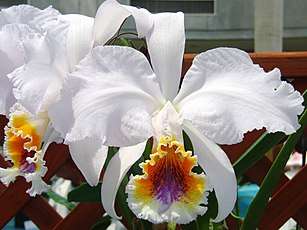
- Light
- Cattleyas need light, but not direct sunlight; in case of intense sunlight, shade must be provided.[14]
- Temperature
- Day temperatures must be between 25-30 °C (77-86 °F) and night temperatures not lower than 10-12 °C (50-53.6 °F).[14]
- Humidity
- Must be between 40-70% with good ventilation; however plants must not be exposed to air currents.[15]
- Watering
- Water only if substrate is dry. It can be done once a week, but it all depends on the environmental conditions and the season.[15]
- Fertilizing
- Cattleyas can survive without fertilizing. However, it is advisable to use nitrogen-based fertilizers without urea; fertilizers must be applied during the growth season.[15] To avoid salt accumulation in the substrate, water thoroughly between fertilizer applications.[15]
References
- "Kew World Checklist of Selected Plant Families". Royal botanic Gardens Kew. Retrieved 21 February 2017.
- Sunset Western Garden Book, 1995:606–607
- "Alphabetical list of standard abbreviations of all generic names occurring in current use in orchid hybrid registration as at 31st December 2007" (PDF). Royal Horticultural Society.
- Buzatto, Cristiano Roberto; Ferreira, Priscila Porto Alegre; Welker, Cassiano Aimberê Dorneles; Seger, Guilherme Dubal dos Santos; Hertzog, Anelise; Singer, Rodrigo B. (2010). "O gênero Cattleya Lindl. (Orchidaceae: Laeliinae) no Rio Grande do Sul, Brasil". Revista Brasileira de Biociências (in Portuguese). 8 (4). ISSN 1980-4849.
- Withner, C. (1988). The Cattleyas and Their Relatives. Volume 1: The Cattleyas. Timber Press. pp. 29–30. ISBN 9780881920994.
- Schweinfurth, C., "Orchidaceae, Orchids of Peru", Fieldiana, Botany 30(3): 535
- "Cattleya, Queen of the Orchids: The Showy Cattleya, Queen of the Orchids, BEGINNERS' HANDBOOK - XV". www.aos.org. Retrieved 29 June 2017.
- Van den Berg, Cássio (2014). "Reaching a compromise between conflicting nuclear and plastid phylogenetic trees: a new classification for the genus Cattleya (Epidendreae; Epidendroideae; Orchidaceae)". Phytotaxa. 186 (2). doi:10.11646/phytotaxa.186.2.2. ISSN 1179-3163.
- "Laelia gracilis - IOSPE PHOTOS". www.orchidspecies.com. Retrieved 28 June 2017.
- "Cattleya hispidula - IOSPE PHOTOS". www.orchidspecies.com. Retrieved 28 June 2017.
- "Cattleya gracilis (Pabst) Van den Berg — The Plant List". www.theplantlist.org. Retrieved 28 June 2017.
- van den Berg, Cássio (2016). "Nomenclatural notes on Laeliinae-VI. Further combinations in Cattleya (Orchidaceae)". Neodiversity. 9 (1): 4–5. doi:10.13102/neod.91.2.
- "Cattleya - World Checklist of Selected Plant Families: Royal Botanic Gardens, Kew". apps.kew.org. Archived from the original on 8 September 2009. Retrieved 1 July 2017.
- Schoser, Gustav (1993). Orchid Growing Basics. Sterling Publishing Company, Inc. p. 64. ISBN 9780806903620.
- "Cattleyas for the Beginner - Part 1". www.aos.org. Retrieved 3 July 2017.
External links


- "WCSP". World Checklist of Selected Plant families. (enter "Cattleya" in search box).
- More info About Orchids Orchids of Costa Rica
- Breeding Cattleya Breeding in Cattleyas
- Painting of a Cattleya by Martin Johnson Heade, 1871 - National Gallery of Art, Washington
- Orchid Picture Gallery
- American Orchid Society - Orchid Web
- Cattleya Orchid Forum
- van den Berg, C. and M.W. Chase. 2000. Nomenclatural notes on Laeliinae - I. Lindleyana 15(2): 115-119.
- Cattleya ochids flowers pictures Photos of Thailand native cattleya orchids
- Orchidroots.org Cattleya Species